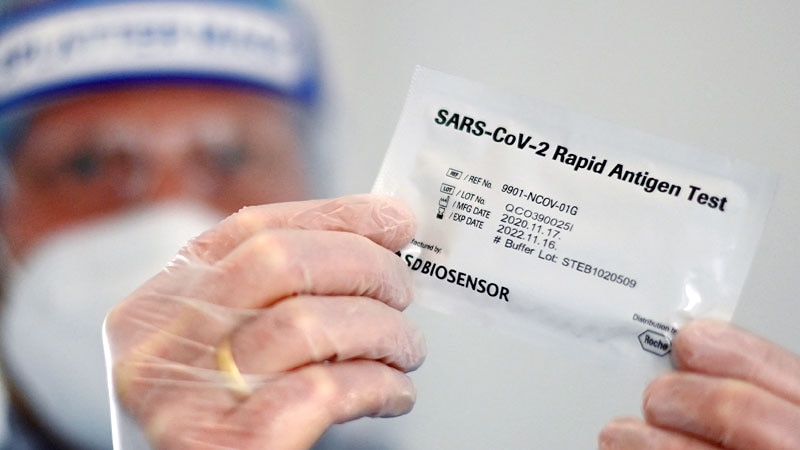Core Concepts
Antigen tests should expand beyond COVID.
Abstract
The content discusses the evolution of lateral flow tests (LFTs) from their limited use before the pandemic to their widespread adoption during COVID-19. It emphasizes the need to expand the role of LFTs to detect various diseases beyond COVID, highlighting the potential benefits and challenges associated with this expansion.
Pre-Pandemic Familiarity with LFTs
- LFTs were not widely known before the pandemic.
- COVID-19 necessitated large-scale testing.
- PCR remains the gold standard for COVID diagnosis.
Current Status of LFTs
- FDA authorizes 32 rapid antigen tests for home use.
- Experts advocate for expanding LFTs to detect other diseases.
- Calls for a global network of LFT research hubs.
Medical Community Support
- Clinicians endorse increased availability of LFTs.
- LFTs offer quick results and ease of use.
- Potential for more LFTs in various healthcare settings.
How LFTs Work
- LFTs target antigens, antibodies, and nucleic acids.
- Process of LFTs explained.
- Global market outlook for LFTs.
Pros and Cons of LFTs
- LFTs provide rapid results but lower accuracy than PCR.
- Challenges and strengths of LFTs discussed.
- Importance of understanding the best use cases for different technologies.
FDA's Perspective
- FDA evaluates LFTs based on individual indications.
- Different pathways for LFT review.
- Recommendations for LFT performance.
Future of LFTs
- Predictions on increased self-testing and seeking care.
- Vision for testing technology evolution.
- Funding challenges post-COVID for LFT research.
Customize Summary
Rewrite with AI
Generate Citations
Translate Source
To Another Language
Generate MindMap
from source content
Visit Source
www.medscape.com
Antigen Tests: After Pandemic Success, Time for Bigger Role?
Stats
By 2030, the lateral flow assays market is predicted to rise to $14.1 billion.
COVID antigen LFTs have a sensitivity ranging from 34.1% to 88.1%.
The lateral flow assays market was estimated at $9.4 billion in 2022.
Quotes
"Rapid antigen tests are critical, made a big difference in the pandemic, and will be used increasingly for many other applications in the years ahead." - Eric J. Topol
"It's a much smarter pathway, gives better outcomes for the patient, is much quicker and at much less cost. And it frees up time for doctors." - Jeremy Stackawitz
Key Insights Distilled From
by Kathleen Doh... at www.medscape.com 09-15-2023
https://www.medscape.com/viewarticle/996506
Deeper Inquiries
How can the medical community ensure the accuracy of LFTs for detecting various diseases?
To ensure the accuracy of LFTs for detecting various diseases, the medical community can implement several strategies. Firstly, rigorous validation and standardization processes should be established to verify the sensitivity and specificity of these tests for different diseases. This involves conducting thorough clinical trials and comparative studies to assess the performance of LFTs against gold standard diagnostic methods like PCR. Additionally, ongoing quality control measures should be put in place to monitor the consistency and reliability of LFT results over time. Collaboration between researchers, clinicians, and regulatory bodies is essential to establish guidelines and protocols for the development, evaluation, and deployment of LFTs in clinical settings. Continuous education and training programs for healthcare professionals on the proper use and interpretation of LFT results can also contribute to maintaining accuracy in disease detection.
What are the potential implications of reduced funding for LFT research post-COVID-19?
Reduced funding for LFT research post-COVID-19 could have significant implications for public health preparedness and disease surveillance. One major consequence could be a slowdown in the development of new LFTs for detecting emerging infectious diseases or known priority diseases with epidemic potential. This could hinder the timely identification and containment of future outbreaks, leading to delays in implementing effective public health interventions. Moreover, decreased funding may limit the optimization of existing LFT technologies, impacting their accuracy, sensitivity, and specificity. Without adequate financial support, research and development efforts in the field of LFTs may stagnate, hindering progress towards decentralized testing and self-testing initiatives that are crucial for addressing future pandemic threats.
How might the widespread adoption of LFTs impact healthcare accessibility and patient outcomes in the future?
The widespread adoption of LFTs has the potential to significantly impact healthcare accessibility and patient outcomes in the future. By making diagnostic testing more convenient, affordable, and readily available, LFTs can improve access to timely healthcare services, especially for underserved populations or in remote areas. Patients can perform tests at home or in community settings, reducing the need for clinic visits and minimizing healthcare disparities. This increased accessibility can lead to earlier detection of diseases, prompt initiation of treatment, and better management of health conditions, ultimately improving patient outcomes. Additionally, the integration of LFTs with digital health technologies, such as mobile apps for result reporting and telemedicine consultations, can enhance care coordination, patient engagement, and personalized treatment approaches. Overall, the widespread use of LFTs has the potential to revolutionize healthcare delivery, making it more patient-centered, efficient, and effective.
0
